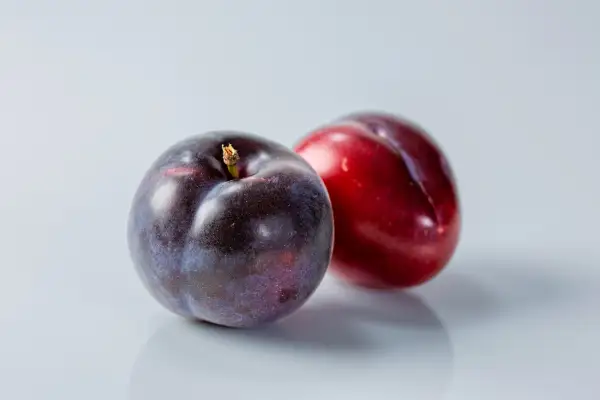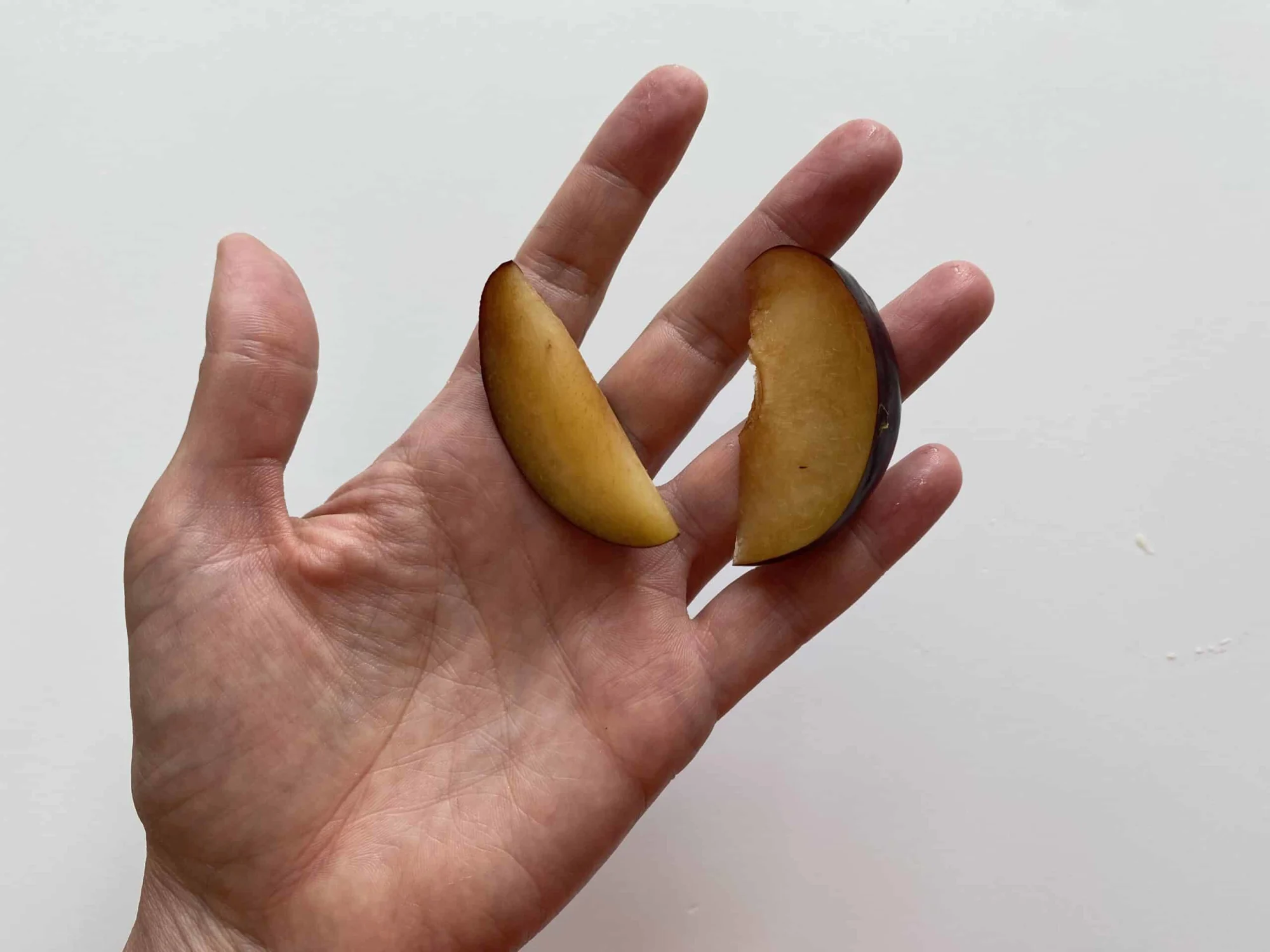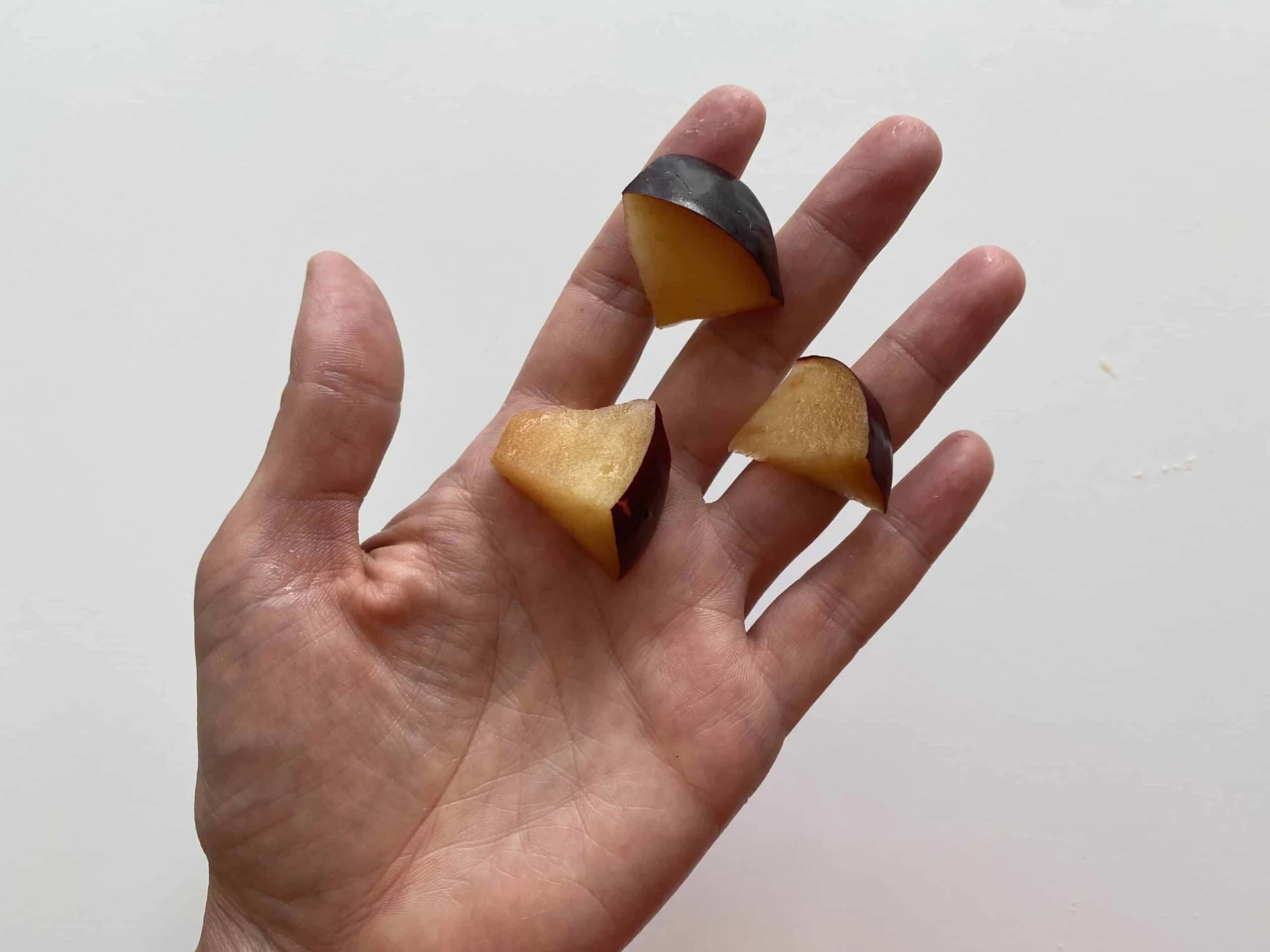Access our First Foods® Database in the Solid Starts App.
Learn morePlum
Fruit
Age Suggestion
6 months
Iron-Rich
No
Common Allergen
No

When can babies have plums?
Plums may be introduced as soon as baby is ready to start solids, which is generally around 6 months of age, as long as the fruit is very soft and ripe or cooked until soft. Learn more about dried plums or prunes here.
Plums are an ancient fruit that grew wild in North America, Europe, and Asia. Today there are thousands of varieties of plums–from the immensely sweet mirabelles and gages, to the deeply tart and tangy damsons. Some are even astringent, such as the blackthorns used to make plum liqueurs like patxaran in Spain and sloe gin in the United Kingdom.
How do you serve plums to babies?
Every baby develops on their own timeline, and the suggestions on how to cut or prepare particular foods are generalizations for a broad audience.
6 months old +:
Offer baby a large, very ripe pitted plum cut in half with the skin on. The fruit should be soft enough that it mashes readily when gently pressed between your thumb and pointer finger. Leaving the skin on helps baby grip the slippery fruit, but if the skin makes you nervous, peel it and roll the plum half in shredded coconut or finely ground-up nuts or seeds to reduce slipperiness and to add grip. If baby bites off a big piece of plum, take a deep breath and refrain from sticking your fingers in baby’s mouth. Instead, you can kneel down in front of baby, encouraging them to look down at you and allowing gravity to help move the food out of their mouth. Alternatively, mash the plum and mix into a soft, easy-to-scoop food like porridge or yogurt. If you feel comfortable, you can offer a whole plum, as long as the fruit is larger than baby’s mouth and very ripe and soft. If baby eats enough of the fruit to expose the pit, feel free to take the food away and offer something else, or remove the pit and give back the rest of the plum for baby to munch on.
9 months old +:
Offer thin slices of soft, ripe plum with the skin on or off. The fruit should be soft enough that it mashes readily when gently pressed between your thumb and pointer finger. If baby is not ready to pick up slices of plum, continue offering pitted plum halves with the skin on or peeled. Because plums are so slippery, bite-sized pieces may be too challenging for baby to pick up, but you can also try rolling small pieces in shredded coconut or finely ground-up nuts.
12 months old +:
Continue with ripe thinly-sliced plums or halved, pitted plums for biting practice. Alternatively, cut ripe plum into bite-sized pieces to pre-load on a fork.
18 months old +:
If you feel comfortable, consider offering the toddler a whole, ripe plum. We recommend you eat one at the same time to demonstrate biting into the plum and how to avoid the pit. Take a few bites and then show the toddler the hard pit on the inside. Tap it with your finger and tell them, “I am eating around this hard part.” If the toddler tries to put the whole pit in their mouth, simply remove the pit for them and let them continue with the fruit flesh. If the child accidentally ends up with a pit in their mouth, try not to panic. Remember that a pit can produce a strong gag reflex to move it forward and out of the mouth. Kneel next to the toddler and tell them in a calm voice: “Spit that out please. Pits are not for eating.” Put your hand under their chin while you demonstrate spitting. If needed, put a pit in your own mouth, show it on your tongue, and demonstrate spitting it into your own hand.


How to prepare plums for babies 6 months +
How to prepare plums for babies 9 months +
Videos
Are plums a choking hazard for babies?
Yes. Plums, especially when underripe, are slippery and can be firm, qualities that increase the risk of choking. To reduce the risk, prepare and serve plums in an age-appropriate way. As always, make sure you create a safe eating environment and stay within an arm’s reach of baby during meals.
Learn the signs of choking and gagging and more about choking first aid in our free guides, Infant Rescue and Toddler Rescue.
Are plums a common allergen?
No. Although severe allergic reactions to plum have been reported, plum is not considered to be a common allergen. Some individuals with a history of severe reactions to certain stone fruits (such as cherry, peach, and nectarine) or latex may be at increased risk of plum allergy. Individuals who are sensitive or allergic to birch trees, or who have Oral Allergy Syndrome (also called “pollen food” allergy syndrome) to other foods in the Rosaceae or stone fruit family, may also be sensitive to plums. Oral Allergy Syndrome typically results in short-lived itching, tingling, or burning in the mouth, and is unlikely to result in a dangerous reaction. Cooking and peeling the fruit may help reduce reactions for those who are sensitive.
As you would do when introducing any new food, start by offering a small amount for the first few servings. If there is no adverse reaction, gradually increase the amount served over future meals.
Are plums healthy for babies?
Yes. Plums offer carbohydrates, fiber, and fluid, in addition to potassium and vitamins C and K. Together, these nutrients help provide energy to fuel crawling and exploration, support the digestive system, and keep baby hydrated. They also help to support electrolyte balance, skin health, iron absorption, immune function, and blood clotting. Plums are among the fruits that are particularly helpful for babies struggling with constipation.
What are some great first foods for babies?
There are many wonderful options. Look for foods that are easy for baby to feed to themselves, that are low in choking risk, and that offer nutrients babies need, such as iron. A few of our favorite first foods include cooked broccoli, oatmeal, and mango pits.
Do I need to start solids with purees?
You can if you’d like, but there's no developmental need to start with textureless food. Babies can be served modified versions of what you eat. Use our First Foods Database to find how to safely serve any food.
Our Team
Written by
Expert Tips Delivered to Your Inbox
Sign up for weekly tips, recipes and more!
Copyright © 2025 • Solid Starts Inc









